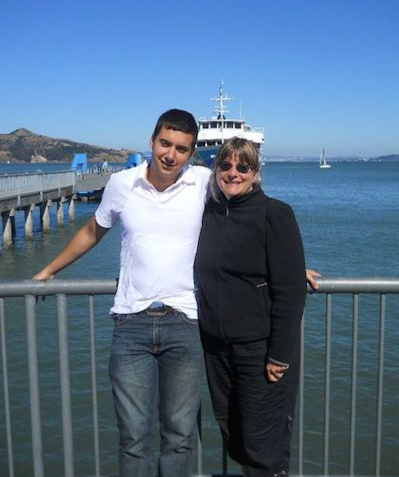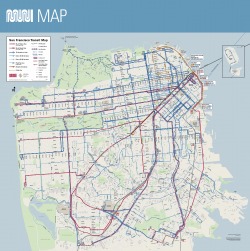- Home
- SF Homelessness
San Francisco Homelessness in 2025
What visitors to San Francisco need to know about the San Francisco homeless situation; tips from an SF local.

Is San Francisco still worth visiting, with all the press about crime and homelessness?
Yes, in my opinion. As a tourist, you have considerable control over your exposure to both crime and the homeless by where you go in the city.
For crime info, i.e. where not to go, see my article on crime in San Francisco.
Read on to discover which areas of San Francisco have the most homelessness, and whether it's a problem for visitors.
The fact that San Francisco has a huge problem with homelessness is no secret. It's in the news almost every day and has generated a lot of controversy, both locally and internationally.
But what is it really like in San Francisco these days?
Key takeaways:
- Yes, San Francisco still has a serious problem with homelessness.
- However, it shouldn't have a major impact on tourists visiting the city...providing they avoid certain areas.
Here's my view of the San Francisco homelessness problem.
I've based this discussion on my experience of living in San Francisco for over 30 years and on the official data collected on the homeless situation in the city, to give you a realistic view of San Francisco in 2025, and what you might expect if you visit.
Homelessness in San Francisco:
the 2024 (latest) report. next one in 2026
Every two years, the city of San Francisco does a one-night count of all it's homeless, both in shelters and on the street. This is a federally funded (and mandated) count done in all cities receiving federal aid.
The counts are done in January, and the latest PIT (point-in-time) count was done on January 30, 2024. The full report was released in the September of 2024.
Results of the January 2024 homeless survey
In January of 2024, 8,323 people were homeless in San Francisco.
Overall homelessness in San Francisco has increased 7% since the last PIT count in 2022.
Of the 8,323 homeless, 4,355 were unsheltered (sleeping on the streets or in vehicles).
The percentage of homeless in shelters has increased from 43% to 48%.
In 2024, 2,913 people were sleeping on the streets in San Francisco, a 13% drop from 2022.
90% of unsheltered families with kids were living in vehicles.
It's not as bad in 2024 as it was in 2019: there were 5,180 unsheltered homeless in the city on that January count. But 2019 had a spike in homeless.
Since the counts started in 2005, there has been a more or less steady climb in the number of homeless in San Francisco.
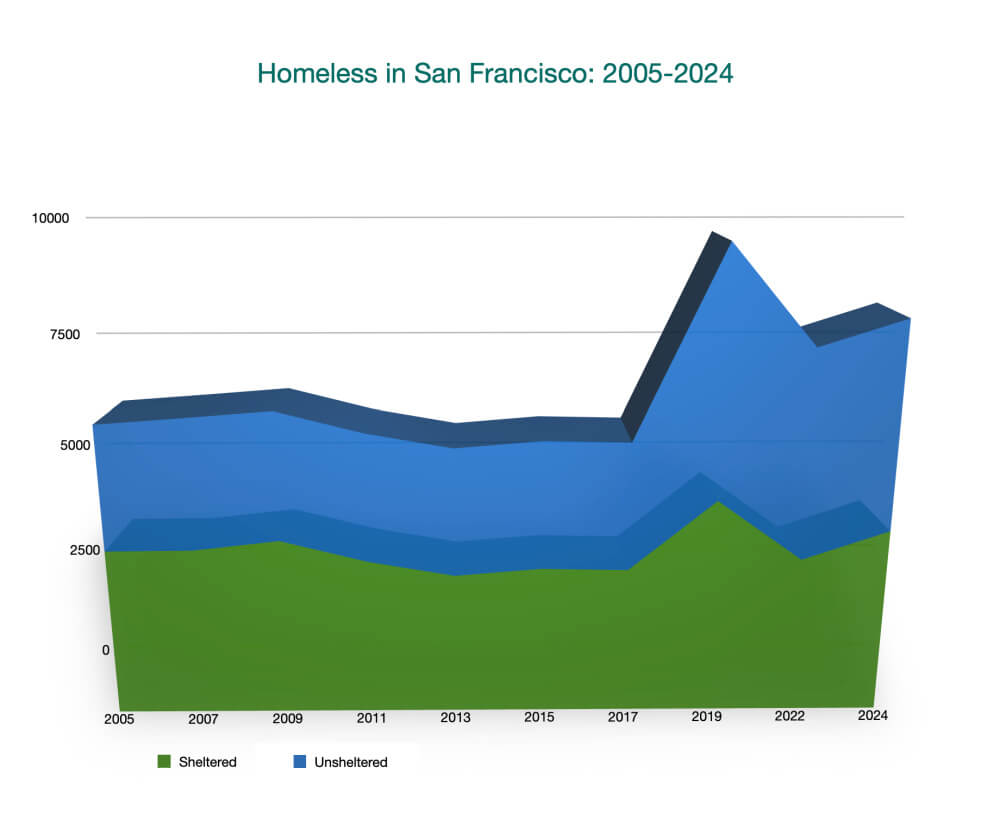 The rise in homelessness over time
The rise in homelessness over timeIs the homeless situation a problem for tourists?
Generally speaking, it shouldn't be a problem, with some reasonable precautions.
The homeless are concentrated in certain areas of San Francisco, so visitors can minimize their experience of the issues by avoiding those areas.
Where are the homeless in San Francisco?
You will see some homeless in the city. But mainly in the Tenderloin district, if you are staying in one of the hotels in that area, or if you go to a theater performance in that neighborhood or in the Civic Center area.
The vast majority of the housing available for the homeless is also in the Tenderloin. So not only does the Tenderloin have the most homeless living on the street, it also has the most formerly homeless being housed there. This produces a concentration of people who have serious drug problems and attracts drug dealers, further dragging down the area.
There are more homeless in the downtown areas as well, especially around Market Street between 5th and 10th Streets.
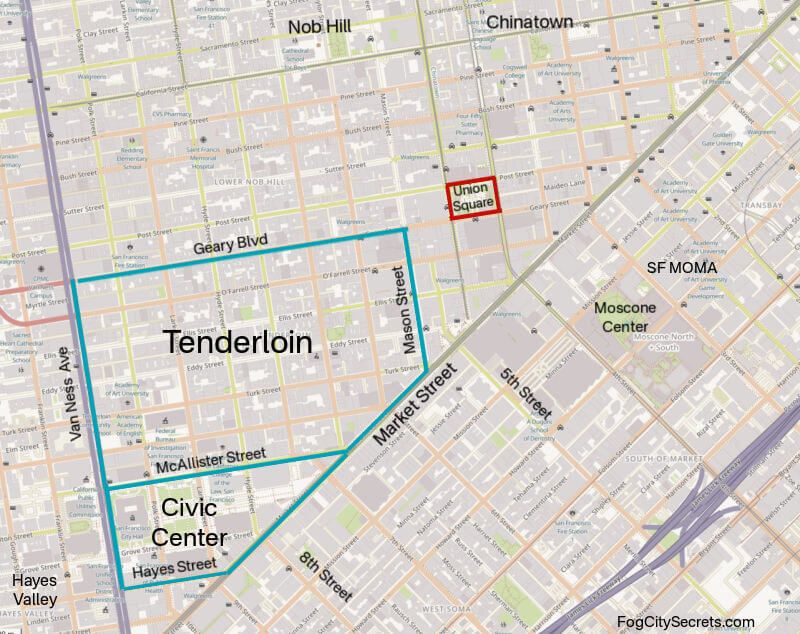 Tenderloin, Civic Center, and Mid-Market Areas
Tenderloin, Civic Center, and Mid-Market AreasAnother area with homeless camps are the areas under freeway overpasses, in the Mission and Potrero neighborhoods, but you're not likely to be walking around in those areas.
In my experience of going here and there, and living in San Francisco, I haven't encountered a lot of homeless, and rarely any homeless camps. But I also rarely visit the Tenderloin, or the mid Market area. However, I have seen a lot of homeless in the Mission District.
There aren't that many homeless in some of the more popular tourist areas like Fisherman's Wharf, Pier 39, the beaches, the Presidio, Chinatown, or North Beach, or along the Embarcadero near the Ferry Building, or near Pier 33 where the ferries to Alcatraz leave from. You will still see some in the tourist areas, but not enough to be oppressive.
You also don't see many out in the residential neighborhoods like the Sunset, Richmond, Marina, Castro and Noe Valley areas.
The Mission District does attract quite a few homeless, and there are some open air markets on Mission Street selling stolen goods, often supplied by thefts committed by drug addicts, many of whom are homeless. Around the BART stations at 18th St. and 24th St. on Mission Street it's particularly bad.
There is some homeless camping in Golden Gate Park, but it's a huge park and most of the homeless aren't near the park museums or lakes.
The SF Chronicle has maps showing where the housikng for homeless is located in the city, broken down by current housing, new housing added recently, and types of housing (families, seniors, etc.). See SF Chronicle housing maps.
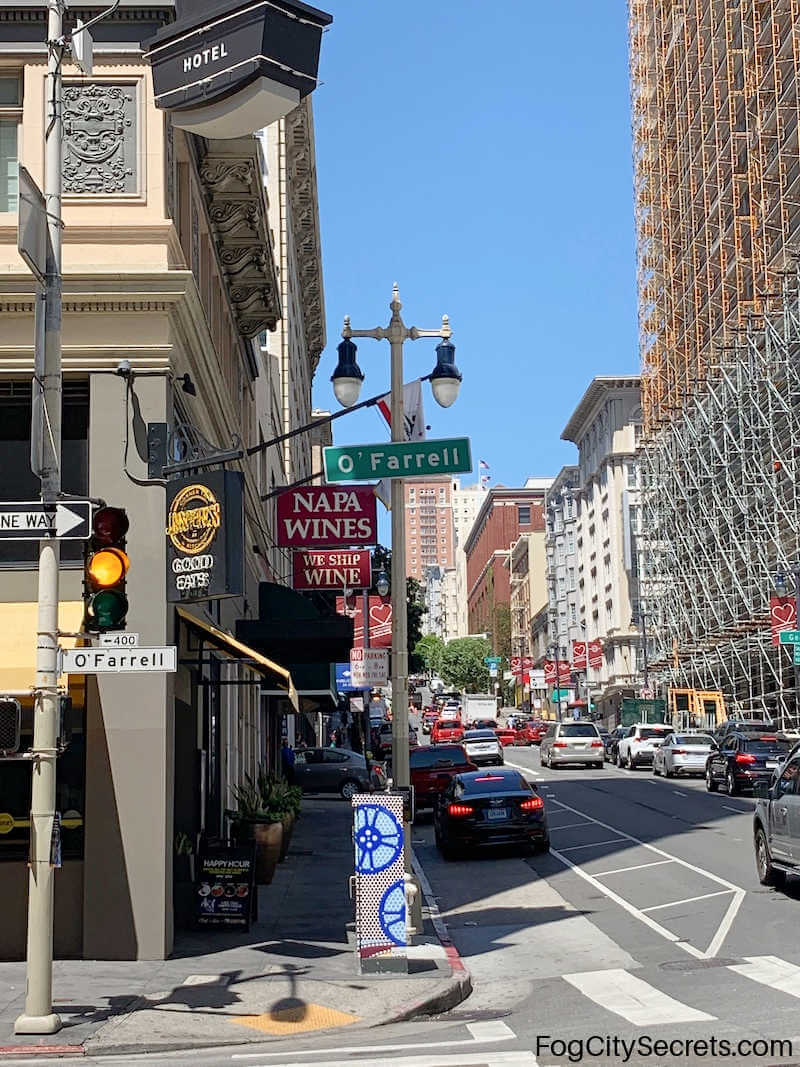 O'Farrell Street in the Tenderloin
O'Farrell Street in the TenderloinThe Tenderloin in the daytime isn't as fearsome as statistics make it seem. As you can see in the photo above, it looks pretty normal. But you can see some ugly stuff here, too.
That intersection is Taylor and O'Farrell Streets, 3 blocks from Union Square.
Are the homeless in SF dangerous?
On the whole, the homeless aren't dangerous, in the sense of committing violent crimes.
There are exceptions, but the disturbing aspects of their presence has more to do with the effects of mental illness and addiction: seeing people having psychotic episodes, or strung out on drugs or alcohol, or both, along with the infamous defecation problems.
Choosing what parts of the city you visit will significantly reduce your contacts with the problem behaviors.
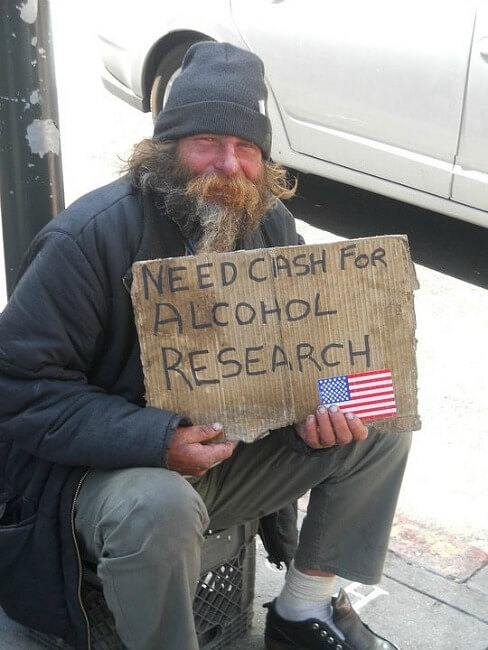
The friendly fellow above has a good sense of humor! He was trying his luck near Union Square.
If you are concerned about crime in San Francisco, see my article on crime statistics in the city, with maps of areas to avoid.
I also wrote an article about the best areas to stay in San Francisco, including the safest areas, with maps and hotel recommendations in those areas.
What is San Francisco doing to deal with the problem?
Shelter beds. The city has shelter beds for 3,240 people, which is less than half of the unsheltered homeless in San Francisco. The latest estimate is that it would take around 1 billion dollars to provide shelter for everyone!
But, even when shelter beds are available, many of the homeless refuse to use them. Mayor London Breed recently tried to set up a requirement for drug testing for eligibility for certain shelters, but the proposal was shot down.
Clearing camps and sidewalks. The city has some legal restrictions on where and how they can clear homeless encampments. They can only clear homeless encampments if there's a place available in a shelter. They can clear camping on the sidewalk if they give 72 hours notice.
Compassion or enabling?
SF Public Health estimates that over half of the homeless have drug or alcohol addictions. Three in five reported addiction, physical disability, or mental health problems (and these were self-reported in the survey).
The overall philosophy in San Francisco for dealing with the problem seems to be focussed on providing housing and supportive care to those addicted to drugs and alcohol, not so much on tough love to get them off the drugs.
Just recently, there has been an effort from law enforcement to arrest and prosecute the drug dealers, partly due to the skyrocketing deaths from fentanyl (plus a mayor facing a re-election challenge). But it can be an uphill battle to get convictions from SF juries, and jail sentences for the dealers (not to mention deportation for the many Honduran dealers who dominate the drug trade here).
The city of San Francisco distributes around 400,000 free syringes to drug users every month. And collects back around 246,000. That means there are roughly 150,000 used hypodermics dumped on city streets every month!
Also, San Francisco has been spending 5 million a year giving free alcohol to homeless alcoholics. The city set up a "managed alcohol program" in 2020, and it's still going. What do they get? Vodka, wine, or beer. Hard to believe! This was supposed to cut down on trips to the ER and reduce police time in dealing with them.
On top of everything else, extensive fraud by one of the non-profit organizations that receives city funds to provide services to the homeless has been uncovered recently.
Is the homeless situation in SF getting better...or worse?
The numbers of homeless in San Francisco is increasing (8323 in 2024 vs 7754 in 2022). But most of the increase in the homeless population received shelter.
So the 7% increase in the homeless hasn't resulted in a noticeable increase in people living on the street.
There was a 9% increase in the chronically homeless, however.
The amount of money San Francisco spends on the homeless has been increasing also. It's hard to come up with a total for the amount SF spends on the homeless because various departments are involved. The primary city department that manages homelessness is the Department of Homelessness and Supportive Housing, which has a budget of $690 million. The budget is 142% higher than it was in 2019 before the pandemic.
San Francisco vs. other U.S. cities
How does homelessness in San Francisco compare with other cities in the U.S.?
That's the actual number of homeless people in each city.
But the cities very enormously in population; for example, Los Angeles (8.9 million) vs, San Francisco (777,000 ), so percentage of homeless is also revealing and gives a better sense of the density of a homeless population.
The percentage of the population that is homeless is not that different between S.F. and L.A.: 0.98% vs. 0.80%. But the population of L.A. is vastly more spread out than San Francisco's, so the homeless appear more concentrated in S.F.
Homelessness per capita in U.S. cities: # per 10,000 residents: 2023
I took the same list of cities from above and calculated the # of homeless per 10,000 residents.
These were for the metro area or the urban county of the city in 2023.
- Denver: 140
- New York City: 106
- San Francisco: 98
- Los Angeles County: 80
- San Diego: 74
- Oakland & Berkeley (Alameda County): 60
- San Jose (Santa Clara County): 52
- Seattle: 40
- Phoenix: 21
Sheltered or unsheltered. There are big differences in the % of homeless that are in shelters, city to city.
For example, around 95% of the NYC homeless are in shelters, vs. 48% for San Francisco and 27% in Los Angeles. Nationally, the sheltered rate is 61%.
Overall Homelessness in the United States (2023 data)
The following stats are based on a homeless count nationwide on one night in January, 2023.
- There were 653,100 homeless people in the U.S. in 2023.
- 28% of the homeless households included children.
- Over 20% of the homeless were over 55 year of age.
- About 31% of the homeless experienced chronic homelessness.
- The number of homeless nationwide increased 12% from 2022 to 2023.
- 39% of all homeless in the U.S. were unsheltered.
So, grim as the homeless numbers are in San Francisco, it's not all bad. There does seem to be more of a political will to tackle the problem now; the pendulum is starting to swing back to sanity.
If you visit San Francisco in 2024, you'll see some homeless, but by avoiding certain areas, you should still enjoy your stay!
Sources for homelessness data:
- Wikipedia: Homelessness in the San Francisco Bay Area.
- 2023 Annual Homelessness Assessment Report, U.S. Dept. of Housing and Urban Development (national stats).
- 2024 10-Year Comparison Report, Biannual SF Homeless Count history in San Francisco.
- 2024 San Francisco Point-in-time Homeless Count Report, (latest SF report).
- 2022 SF Comprehensive Report, San Francisco Homeless Count and Survey.
- Which US cities have the largest homeless populations, usafacts.org.
- Fact vs. opinion: Here's what you need to know about homelessness in San Francisco, Dec 30, 2023.
Share this page:
